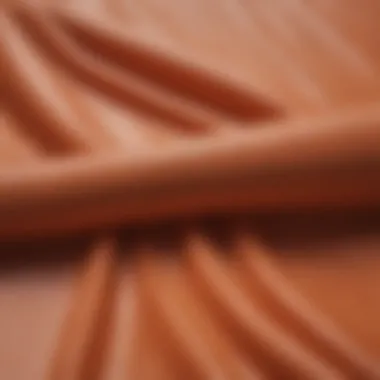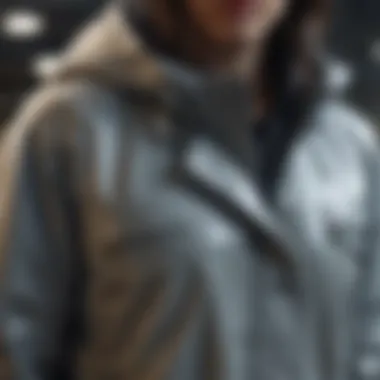Exploring Top Rain Coats for Stylish Women


Intro
Rain coats serve as a fundamental element in many women’s wardrobes, transcending mere functionality to become stylish statements. As climate patterns shift and unexpected showers become the norm, the demand for fashionable yet practical rain coats has grown. Women today seek options that cater to both aesthetic sensibilities and usability, thus making this exploration vital for savvy shoppers. This article aims to dissect what makes the ideal rain coat, highlighting key features and style considerations, while providing recommendations for the best products on the market.
Fashion Trends
Seasonal Styles
The fashion landscape for rain coats evolves with the seasons, presenting new colors and cuts. In spring and autumn, lighter materials such as nylon and polyester are favored, offering breathability while retaining waterproof capabilities. Additionally, vibrant colors become more popular as the dreary weather prompts consumers to express their personality through their attire.
During winter, coats with insulation and heavier materials dominate. Styles such as trench coats and parkas are sought for their combination of warmth and weather resistance. Women are increasingly leaning towards multifunctional designs that can be worn in various settings — from casual outings to elegant gatherings.
Influencer Inspirations
Social media has a significant impact on fashion trends, with influencers showcasing rain coats in various contexts. For instance, urban-style looks featuring oversized rain coats paired with high-fashion accessories are trending. Influencers often highlight brands like The North Face and Hunter, which successfully integrate style with resilience against adverse weather conditions. Such insights inspire many to curate their own styles, molding them into personalized versions of trending designs.
Practical Features of Rain Coats
When selecting a rain coat, several elements must be considered to achieve the perfect blend of fashion and functionality.
- Waterproof Material: Look for coats labeled as waterproof or water-resistant. Materials such as Gore-Tex or PVC are ideal.
- Breathability: Ensuring that the coat allows air circulation is crucial to comfort. Look for vents or breathable fabrics.
- Length: Mid-thigh or knee-length coats offer more coverage and can be stylish when layered.
- Pockets: Functional pockets add practicality, especially when on the move.
This thoughtful consideration of features not only enhances style but contributes significantly to the overall user experience.
"The best rain coat is one that harmonizes comfort, utility, and aesthetics, allowing women to navigate the elements without compromising style."
Finale
In summary, the exploration of rain coats reveals much about contemporary fashion choices made by women. As functionality and style continue to intersect, the selection of adequate rain apparel becomes an informed decision shaped by preferences and lifestyle needs. By understanding seasonal trends and practical features, an informed purchase can be made, ensuring they remain stylish and dry during inclement weather.
Intro to Rain Coats
The consideration of rain coats goes beyond mere necessity; it nests firmly within the intersection of practical utility and style. In regions often subjected to inclement weather, rain coats offer protection against the elements while defining an individual’s aesthetic. The modern woman’s wardrobe demands versatility, and rain coats exemplify this through their varied styles and functionalities.
In this article, we look deeper into the significance of rain coats, not only as a fashion statement but also as an essential item for maintaining comfort during wet conditions. The right rain coat can enhance one’s entire look, from casual outings to more formal events, ensuring that one remains both fashionable and functional.
Understanding the nuances of rain coats helps consumers make informed choices. It is critical to evaluate materials, designs, and personal needs to find a suitable option. The following sections will dissect these elements comprehensively, providing key insights into the rain coat landscape.
The Role of Rain Coats in Fashion
Rain coats serve as a vital element in women's fashion. They come in various styles, allowing for expression and personality, even on gloomy days. With aesthetics evolving, the perception of rain coats has transformed; they are no longer just a protective garment but a designer statement.
Contemporary brands have taken this further by incorporating innovative designs with quality materials. Thus, rain coats have become synonymous with sophisticated fashion choices, adaptable for any occasion. They can be styled with jeans for a casual look or paired with dresses for a more refined appearance. The blend of functionality and fashion highlights the importance of selecting a rain coat that fits personal style while serving its primary purpose.
Historical Context of Rain Coats
The rain coat has a rich history marked by evolution and adaptation. Originally designed for sailors, waterproof garments emerged from necessity. Early rain coats utilized rubber or oilcloth, materials suited for waterproofing.
Over time, advancements in textile technology led to lighter and more breathable options. Fabrics like Gore-Tex and other coated materials emerged, allowing for better moisture management without compromising comfort. Today, the functionality of a rain coat emphasizes not only weather resistance but also design considerations that cater to modern tastes.
The historical journey of rain coats reflects broader changes in fashion and utility, providing insight into why they hold a valuable place in today's wardrobes. Understanding this context helps consumers appreciate the craftsmanship and thought that go into producing both stylish and functional rain coats.


Key Features of Top Rain Coats
Understanding the key features of rain coats is essential in choosing the right option for varying weather conditions. Each element contributes to both functionality and style, which makes it pivotal in this guide.
Material Considerations
Waterproof Fabrics
Waterproof fabrics are critical for any effective rain coat. These materials are designed to resist water penetration, keeping the wearer dry. A common characteristic is a tightly woven structure, which prevents water from soaking through. Materials such as Gore-Tex and nylon are popular choices among manufacturers. They are beneficial because they offer full waterproof capabilities while maintaining a lightweight profile. However, it is important to note that not all waterproof fabrics perform equally under extreme weather conditions, which could lead to discomfort or leakage.
Breathability
Breathability in rain coats refers to the fabric's ability to allow moisture vapor to escape while blocking rain. This feature is crucial for those who engage in physical activity while wearing a rain coat. Breathable fabrics often incorporate advanced technologies, ensuring that excess heat and sweat do not accumulate inside the coat. A well-breathing coat keeps the wearer comfortable. On the downside, high-breathability fabrics might lack complete waterproof qualities, which can be a trade-off in certain situations.
Insulation
Insulation in rain coats adds a layer of warmth without sacrificing waterproof qualities. Features like fleece lining or thermal layers enhance comfort during colder temperatures. Insulated rain coats often provide the right balance, allowing wearers to stay warm while also shielding them from precipitation. A drawback could be that extra insulation can increase weight and bulk, which may not be ideal for everyone.
Design Aspects
Fit and Cut
The fit and cut of a rain coat significantly influence both comfort and style. A tailored fit can enhance the coat's aesthetic appeal without compromising mobility. This design consideration allows for a more flattering silhouette, making it a preferred choice for many women. However, a very fitted rain coat may limit layering options, which can be a concern in colder weather.
Style Variations
Different style variations of rain coats cater to diverse tastes and occasions. From classic trench coats to sporty rain jackets, each style offers unique attributes. Trench coats often exude sophistication, while rain jackets provide a more casual look. The right style depends on the wearer's personal preference but also impacts how the coat performs in various settings.
Color Options
Color options in rain coats are not just about aesthetics but also about personal expression. Available in a wide spectrum from muted tones to vibrant shades, color can affect visibility and mood during rainy days. Bright colors may enhance safety, particularly during low-visibility conditions. The downside is that lighter colors can show dirt more quickly, necessitating more frequent cleaning.
Functional Elements
Pockets
Pockets in rain coats serve functional purposes, offering a place to store essentials like keys and phones. They can also enhance the coat's overall design. Features such as waterproof zippers or flaps on the pockets contribute to keeping items dry. However, placement and depth of pockets can vary, affecting ease of access and utility.
Adjustable Features
Adjustable features such as hoods, cuffs, and waistbands offer customizable fit and protection against the elements. These elements allow the wearer to modify the coat for comfort and efficiency. For example, a snug hood can prevent rain from entering, while adjustable cuffs can block wind. Although they add convenience, over-adjustability can lead to wear and tear over time.
Weight and Portability
Lightweight and portable rain coats are ideal for individuals who are frequently on the go. Their design allows for easy packing, often making them suitable for travel. However, lighter materials may compromise durability or insulation. This weight consideration is essential for those who balance comfort with the need for protection against the elements.
"When choosing a rain coat, focus on materials, design, and functionality that aligns with your needs."
In summary, evaluating the key features of rain coats helps in making informed decisions. Understanding each aspect will allow for a personalized choice that matches both style and functionality.
Popular Types of Rain Coats
Understanding the various types of rain coats is essential in making an informed choice. This variety offers different advantages suited to specific situations and personal styles. Weather conditions, activities, and individual preferences greatly influence the selection of a rain coat. By exploring popular categories such as trench coats, rain jackets, parkas, and ponchos, readers can identify which style aligns best with their needs. Each type brings unique features that enhance utility while maintaining an aesthetic appeal.


Trench Coats
Trench coats are a classic choice for rainy weather. Their design often includes a long silhouette and a belted waist, providing a sophisticated look. Made from materials like cotton gabardine or polyester blends, trench coats typically have a water-resistant finish. The benefit of choosing a trench coat lies in its ability to transition easily from casual to formal settings. This versatility makes it a staple in many women's wardrobes. The iconic design adds to its timeless quality, ensuring it never goes out of style. Furthermore, trench coats often come with features such as:
- Double-breasted fastenings: These keep the coat securely shut, offering better protection from wind and rain.
- Epaulettes and storm flaps: These design elements enhance functionality while also contributing to the coat's overall style.
Rain Jackets
Rain jackets are designed primarily for active lifestyles. Typically lighter than trench coats, they often include elements like adjustable hoods and elastic cuffs to keep moisture at bay. These jackets are usually made from synthetic materials, providing excellent waterproofing and breathability. They are ideal for outdoor activities such as hiking, cycling, or running. Their packable design makes them convenient for travel. The key benefits of a rain jacket include:
- Lightweight structure: This allows for ease of movement, making them suitable for physical activities.
- Ventilation options: Many models are designed with mesh linings or ventilation zippers for improved airflow, preventing overheating.
Parkas
Parkas are typically longer and provide extra warmth, making them a suitable choice for colder, rainy weather. Often insulated, parkas can keep you warm and dry during harsh conditions. They may feature a fur-lined hood for added comfort and protection against wind. Parkas are favorable for those who want a rugged, outdoor-ready option. Important features to note include:
- Extended length: This helps to keep the entire body covered, offering more protection.
- Multiple pockets: Useful for storing essentials, parkas often include various pockets to maintain accessibility.
Ponchos
Ponchos are a versatile option that can easily be worn over different outfits. They are designed to drape loosely over the body, providing coverage without being restrictive. Often made of lightweight waterproof material, ponchos are easy to pack and carry, thus suitable for unexpected rain. Their one-size-fits-all design is a major advantage, appealing to a wide range of consumers. Key aspects include:
- Easy to wear: Simply throw it on over your clothing for instant protection against rain.
- Breathable material options: Many ponchos are designed with ventilation, ensuring comfort during wear.
Evaluating the Best Rain Coats
Evaluating the best rain coats is critical for anyone wanting to merge functionality with fashion. This section focuses on the specific criteria that aid buyers in making informed decisions. Understanding the elements that contribute to the performance, style, and value of rain coats ensures that the selection meets personal requirements and preferences.
Criteria for Selection
Performance Metrics
Performance metrics are essential in determining how well a rain coat can perform under varied conditions. These metrics typically assess the waterproofing capabilities, durability, and overall performance during inclement weather. A rain coat with high waterproof ratings will keep the wearer dry, even in heavy downpours. Additionally, features like seam sealing contribute to the effectiveness of the rain coat, preventing water ingress at critical points. Performance metrics ensure that the chosen coat is not just a fashion statement but also a reliable shield against rain.
Style Adaptability
Style adaptability refers to how well a rain coat can fit into various fashion contexts. It is crucial for users who wish to maintain style while braving adverse weather. A versatile rain coat can transition from casual to formal settings without losing its appeal. Features such as removable linings or adjustable lengths enhance style adaptability. This ensures that the coat can be worn across different seasons or events, increasing its usability beyond just rainy days.
Value for Money
Value for money encompasses the overall benefits derived from the rain coat relative to its cost. A higher price does not always equate to better quality. It is important to assess factors such as material quality, longevity, and brand reputation. A rain coat that lasts multiple seasons can be deemed more valuable than a cheaper option that falls apart after one use. This consideration is important, especially for budget-conscious shoppers.
Top Brands in the Market
When considering the best rain coats, brand reputation holds significant weight. Consumers often gravitate toward brands known for quality and performance. Established brands consistently deliver products that satisfy varying needs. Their history of reliability often reassures customers about the quality of their purchase.
Brand Reputation
Brand reputation is indicative of a manufacturer’s consistency in producing high-quality rain coats. Renowned brands often invest in research and development, ensuring cutting-edge technology in their products. A strong reputation signifies trust, making brands like North Face or Columbia popular choices. Choosing a reputable brand reduces the risk of disappointing purchases.
Customer Feedback
Customer feedback plays a vital role in evaluating rain coats. Reviews provide insight into real-world performance, durability, and comfort. Positive comments often highlight the practical benefits of a coat, while critical feedback can outline weaknesses or potential issues. It is a good practice to analyze customer feedback to gauge how a coat performs over time and under various conditions.


Innovative Features
Innovative features set the best rain coats apart from the competition. Features such as reflective materials for safety, advanced breathability technologies, or eco-friendly fabric choices can greatly enhance a coat’s appeal. Brands that focus on innovation often provide significant benefits, including improved comfort and functionality. This guarantees that the user enjoys both style and practicality.
When evaluating rain coats, keep in mind that the best choice balances performance, style adaptability, and value for money.
Practical Recommendations
Practical recommendations are a cornerstone of making informed choices in the realm of rain coats. This section emphasizes the importance of not only selecting a stylish coat but also ensuring it meets individual requirements and withstands varying weather conditions. Addressing practical aspects allows buyers to invest wisely in an essential wardrobe piece that balances functionality and aesthetic appeal. These recommendations are derived from understanding personal needs and learning how to care for the coat effectively.
Choosing the Right Rain Coat
Assessing Personal Needs
Assessing personal needs is crucial when selecting a rain coat. Different individuals have distinct lifestyles and preferences that influence their choice. Understanding the primary purpose for which one needs a rain coat can lead to a more satisfactory purchase. The key characteristic here is relevancy; for instance, a commuter might prioritize lightweight options, while someone who spends time outdoors might need more insulated designs.
One unique feature of assessing personal needs is the focus on lifestyle integration. A rain coat that fits seamlessly into daily life enhances its usability and value. If someone frequently travels, a packable rain coat may be advantageous. That said, overlooking personal needs might result in a less practical choice, ultimately diminishing user satisfaction.
Adapting to Weather Conditions
Adapting to weather conditions is another vital consideration when choosing a rain coat. The significance of this aspect cannot be overstated since weather can vary widely and impact comfort. A rain coat designed for specific climates ensures better protection and comfort. For instance, a fully waterproof coat is essential in areas with heavy rainfall, while a water-resistant option may suffice for light showers.
The key characteristic of adapting to weather conditions is its preventive nature. By selecting a coat that accurately reflects local climate needs, individuals can avoid being caught off-guard. A unique feature of this adaptability is the inclusion of adjustable components like hoods and cuffs, adding versatility. However, one might find that overly specialized coats can become cumbersome in transitional weather.
Care and Maintenance
Cleaning Instructions
Cleaning instructions are essential for maintaining the longevity of any rain coat. Proper care directly impacts performance, making it a necessary discussion point in this guide. The key characteristic of cleaning instructions lies in their specificity; different materials require distinct cleaning techniques and products. Many modern rain coats are made from synthetic materials that can be machine washed, while others may need gentle hand washing.
Adhering to the right cleaning instructions can enhance waterproofing and breathability; however, improper cleaning may lead to diminished performance. Unique to certain brands, the use of specialized detergents can help restore water-repellent finishes. Neglecting this aspect could lead to unnecessary wear and reduced lifespan of the coat.
Storing Tips
Storing tips are often overlooked, but they play an important role in the preservation of a rain coat's integrity and functionality. Appropriate storage practices can help maintain the shape and materials of the coat, ensuring that it performs well when needed. One key characteristic is ensuring that the coat is stored in a cool, dry place, preventing moisture build-up.
A unique feature of effective storing is the use of padded hangers or keeping the coat in a breathable garment bag, which can prevent deformity. In contrast, crumpling or compressing the coat in tight spaces could lead to fabric damage. Caring for your coat when it is not in use contributes to its lifespan and functionality.
Closure
In this article, the role of rain coats transcends mere practicality, serving both functional and aesthetic purposes in women's fashion. The conclusion serves as a vital synthesis of insights discussed throughout the guide, underscoring the significance of selecting a rain coat that caters to personal style while also providing reliable protection against the elements. Women today face diverse weather conditions, and the right rain coat can act as a fortress against rain without compromising on style.
Recognizing the key elements such as material, design, and functional features empowers readers to make informed decisions. The exploration of brands and their reputations further supports this objective, providing a clear picture of available options. Travelers, commuters, or anyone venturing outdoors will find that a quality rain coat is indeed a worthy investment.
"A rain coat not only ensures comfort but also enhances confidence in challenging weather conditions."
Recap of Key Insights
To wrap up, it is essential to highlight the main takeaways from our exploration of rain coats:
- Importance of Material: Waterproof fabrics that balance breathability and insulation are crucial. Options like Gore-Tex and other advanced synthetic fabrics offer reliable protection.
- Style and Versatility: Trench coats, rain jackets, and parkas each offer unique styling options, allowing women to select pieces that resonate with their personal aesthetics.
- Functional Features: Key features such as adjustable elements and ample pockets elevate practicality, ensuring that lifestyle needs are met without compromise.
- Brand Choice Matters: Considering a brand's reputation and customer feedback can guide buyers towards more satisfying purchases.
Future Trends in Rain Coat Design
Looking ahead, innovation in rain coat design is shaping new consumer expectations. Emerging trends include:
- Sustainable Materials: Brands are shifting towards eco-friendly fabrics, highlighting a growing consumer awareness concerning environmental impacts.
- Smart Technology Integration: Wearable tech features could include built-in weather sensors, making rain coats more adaptive to changing conditions.
- Fashion-forward Designs: Designers are expected to incorporate more vibrant colors and patterns, allowing for greater personal expression even in wet weather.
- Customization Options: Tailored designs that allow for personalization can enhance customer satisfaction.
In summary, the future of rain coats promises exciting advancements that embrace both function and fashion. By staying informed, readers can choose rain coats that reflect not only their needs but also their personal style.



